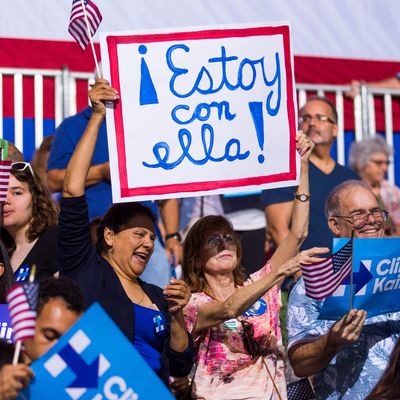
The biggest news in the presidential race Saturday morning comes out of Nevada, where a Friday night spike in Latino early voting appears to have given the Democrats a bigger pre–Election Day advantage than they enjoyed there in 2012 — when Barack Obama won the state by nearly seven points.
Thus, barring an unprecedented (though, possible) spike in rural-white turnout on Election Day, Hillary Clinton will take Nevada. And if she does, Trump’s path to the presidency narrows to a tightrope: In FiveThirtyEight’s model — by far the most generous to the GOP nominee, due to the amount of uncertainty built into its projections — Trump has a 35 percent chance of winning the White House Tuesday; if he loses Nevada, that figure drops to 9 percent.
And the uptick in Latino turnout is not limited to Nevada. As of Saturday morning, Latino voters accounted for 14.1 percent of all early ballots cast in Florida — at this point in 2008, the last year for which we have comparable data, that figure was 9.6 percent, according to CNN.
Now, an optimistic Republican would note that this increase doesn’t, by itself, mean that more Latinos are voting this year, but merely that more Latinos are voting early. Which is to say, it’s possible that the Clinton campaign is just depleting its share of the Election Day vote by getting reliable Democrats to come out earlier than they did for Obama in past elections.
But data gathered by Florida political analyst Steve Schale Friday night suggests otherwise.
Voters are “low propensity” if they have never voted before, or else have participated in only one of the last three general or midterm elections. Since Democrats are outpacing Republicans with such voters — and Latinos make up a disproportionate share of the low-propensity vote — it’s exceedingly likely that the uptick in turnout is being fueled, in large part, by less-reliable Latino voters.
What’s more, there’s reason to think Democrats have an advantage with “NPA” or “not party affiliated” voters.
That said, as of Friday, white turnout was also up significantly in Florida, including in several heavily Republican counties. But according to the Catalist data reported on Saturday by CNN, this increase hasn’t kept pace with the uptick in Latino early voting.
If these trends continue through Election Day, one could reasonably expect Clinton to outperform her polls in the Sunshine State. The RealClearPolitics polling average of Florida currently puts Clinton ahead there by one point. (And if Hillary wins Florida and Nevada, it’s game over).
Latinos represent a much smaller portion of the electorate in North Carolina than they do in Florida or Nevada. But their turnout is up in the Tarheel State to a degree that could prove significant in a razor-tight race.
As of Saturday morning, Latinos had cast 1.8 percent of the early votes in North Carolina, up from 1.2 percent at this point in 2012.
And, like in Florida, there’s reason to think a significant portion of that increase is coming from low-propensity voters.
Finally, in Georgia, Latinos have accounted for 1.7 percent of the early-voting electorate, nearly twice the 0.9 percent share they represented at this point in 2012. While Georgia is a likely Trump state, an NBC News/Wall Street Journal poll published Thursday showed Clinton and Trump statistically tied in the Peach State.
All and all, the central takeaway from the early-voting figures appears to be that viciously attacking a large but politically disengaged voting block isn’t the wisest strategy for a presidential candidate to pursue.






























